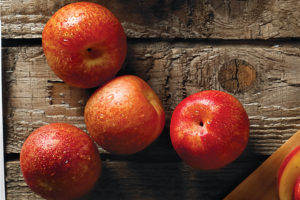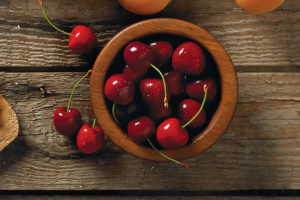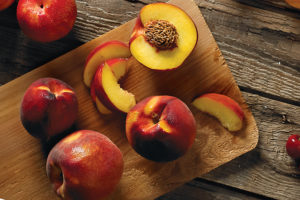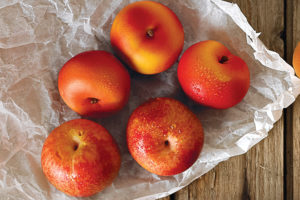
Nothing says summer quite like the sweet, juicy flavors of stone fruits. Whether you prefer peaches, plums, nectarines, apricots or cherries — or any of their hybrids — act quickly: Unlike apples or pears, fresh stone fruits don’t store well.
“Stone fruit” is more of a culinary term than a botanical one. It comes from the stone-hard covering found around the single large seed at the fruit’s core. The stone supports the fruit as it hangs off the tree branch by its stem and provides a passage for nutrients to flow from the tree to the growing fruit.
Stone fruits are species of Prunus, members of the large rose family. A surprising stone fruit is the almond. On the tree, almonds look like small, hard, green peaches; an almond shell (found inside the green peach-like hull that’s removed after the almond is plucked from the tree) looks similar to a peach pit, and the kernel — which is what we eat — is the fruit’s seed. Culinary experts often point to a slight almond flavor in stone fruits, and that’s one reason why cherries, peaches and apricots pair so well with almonds in recipes.
Peaches, nectarines, apricots, plums and their hybrids are best ripened at room temperature, stem-end down. Don’t refrigerate fruit before it’s ripe, or it may develop unappetizing wrinkled skin and mealy flesh. Ripe fruit is soft, has a sweet aroma and can be stored in the refrigerator for a few days. Cherries are ready to eat when purchased and can be kept in the refrigerator, loosely covered, for up to three days.
Stone fruits are delicious simply eaten as is, when they’re at their peak of ripeness. But they also can be roasted, poached or sautéed, baked into pies and crumbles, tossed into salads, made into jams or used as a sauce or topping for both savory and sweet dishes.
Apricots

Apricots are rich in pectin, which provides their creamy texture when eaten ripe and their meatiness when dried. This delicate fruit is most often canned or dried. Dried apricots often are treated with sulfur dioxide to help preserve their naturally light color. Unsulfured apricots are browner with a slightly cooked taste.
Apriums

Like pluots, apriums are an apricot-plum hybrid, but with more apricot characteristics than plum. While apriums look, smell and taste more like apricots, they are juicier and have a slightly firmer flesh.
Cherries

Sweet or sour, cherries are a good source of vitamin C and potassium. Since they must be picked ripe, cherries are a fragile crop. Sweet cherries, including Bing, Rainier and Sweetheart varieties, mainly are sold fresh, but most cherries grown are sour varieties and typically are canned, frozen or dried.
Nectarines

Genetically speaking, nectarines and peaches are not very different, except nectarines have a smooth skin while peaches have fuzz. Like peaches, a nectarine’s flesh may be white or yellow. These cousins can be used interchangeably in recipes, but nectarines offer the advantage of having no skin to peel.
Peaches

Peaches come in clingstone and freestone varieties. As the name implies, a clingstone’s fruit doesn’t fall off its pit, making it fine for eating but a chore for slicing. However, a freestone’s fruit easily separates from its pit. You can’t tell whether a peach is a clingstone or freestone by its looks, but clingstones typically arrive first at farmers markets, followed by freestones.
Plums

Most plums fall into two main types: Asian and European. Asian plums are larger and rounder than their smaller, oval-shaped European counterparts. Asian plums are almost always eaten fresh; European varieties usually are dried or made into preserves. Fresh plums are a good source of vitamin C, while dried plums — also known as prunes — provide fiber and vitamin A, and may be puréed and substituted for fat in cakes, quickbreads or muffins.
Pluots

Akin to the aprium, the pluot boasts more plum parentage than apricot. Without a plum’s bitter skin, smooth-skinned pluots have a more complex aroma. Plumcots are similar to pluots, but this hybrid is comprised of equal parts plum and apricot.
